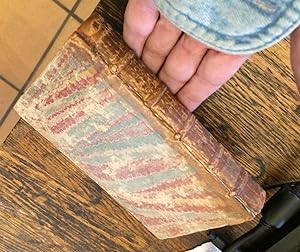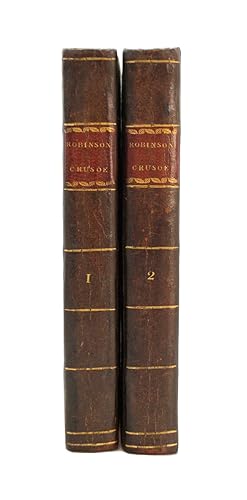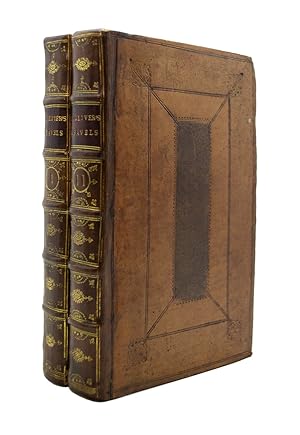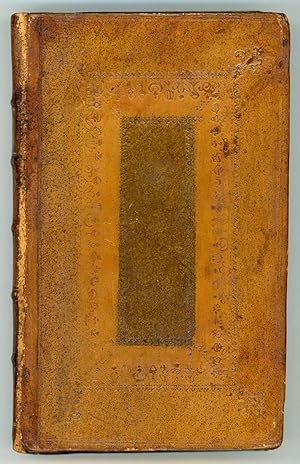fiction (Plus de 2 900 résultats)
Type d'article
- Tous les types d'articles
- Livres (2 878)
- Magazines & Périodiques (2)
- Bandes dessinées (1)
- Partitions de musique
- Art, Affiches et Gravures (18)
- Photographies
- Cartes (7)
-
Manuscrits &
Papiers anciens (3)
Etat
Reliure
Particularités
- Edition originale (717)
- Signé (27)
- Jaquette (47)
- Avec images (1 707)
- Sans impression à la demande (2 893)
Livraison gratuite
Pays
Evaluation du vendeur
-
The Life and Strange Surprizing Adventures of Robinson Crusoe; The Farther Adventures of Robinson Crusoe; Serious Reflections During the Life And Surprising Adventures of Robinson Crusoe.
Edité par Printed for W. Taylor at the Ship in Pater-Noster-Row 1719-1720, London, 1719
Vendeur : Raptis Rare Books, Palm Beach, FL, Etats-Unis
Edition originale
Exceedingly rare complete first edition set of all three books in Defoe's classic Robinson Crusoe series, including the scarce first and only printing of the third book in the series. Octavo, three volumes bound in full crushed red morocco by Francis Bedford with gilt titles and tooling to the spine in six compartments within raised gilt bands, triple gilt ruling to the front and rear panels, gilt turn-ins and inner dentelles, marbled endpapers, all edges gilt. The set consists of: Vol. I. The Life and Strange Surprizing Adventures of Robinson Crusoe, of York, Mariner: Who lived Eight and Twenty Years, all alone in an un-inhabited Island on the Coast of America, near the Mouth of the Great River of Oroonoque; Having been cast on Shore by Shipwreck, where-in all the Men perished by himself. With An Account how he was at last as strangely deliver'd by Pyrates. Written by Himself. First edition, mixed state with the famed engraved frontispiece portrait of Robinson Crusoe by Clark and Pine, the title in second state with semi-colon after London, third state of the preface with the catchword "apply" correctly spelled, and first state of Z4r with "Pilot" misspelled "Pilate" and "Portugnese" for "Portuguese", four pages of advertisements at rear. Bibliographic note tipped in. Vol. II. ; Being the Second and Last Part of His Life, And the Strange Surprizing Accounts of his Travels Round three Parts of the Globe. Written By Himself. First edition, second issue with the publisher's notice to the verso of the last leaf of the Preface and page 295 corectly numbered, folding map of the world and 11 pages of advertisements at rear. Volume III. : With His Vision of the Angelick World. Written By Himself. First edition, first issue with the catchword "The" on page 270, folding engraved plan of Crusoe's island by Clark and Pine, 2 pages of advertisements at rear. [Grolier English 41; Hutchins 52-71, 97-112, 122-8; Moore 412 & 417; PMM 180; Rothschild 775]. In fine condition. An exceedingly rare and handsomely bound complete set of this cornerstone in English literature. Often hailed as the first novel in the English language and purportedly based on the experiences on Alexander Selkirk, who spent four years on the uninhabited island of Juan Fernandez from 1704, the adventures of Crusoe and his companion Friday have attained mythical status in the history of Western literature. The book's success was immediate, a second edition being called for only seventeen days after publication of the first on April 25, 1719, with a further two editions published before the end of year. The Farther Adventures appeared on August 20, and relates how Crusoe revisited the island with Friday. A final part, The Serious Reflections, followed in 1720. "The romance of Crusoes's adventures, the figure of civilized man fending for himself on a desert island, has made an imperishable impression on the mind of man. much of modern science fiction is basically Crusoe's island changed to a planet" (PMM).
-
Travels into Several Remote Nations of the World . . . by Lemuel Gulliver
Edité par London: Benj. Motte, 1726
Vendeur : 19th Century Rare Book & Photograph Shop, Stevenson, MD, Etats-Unis
Livre
Hardcover. Etat : Very Good. Two volumes. Second state of portrait as usual. Two volumes. Second state of portrait as almost always. Contemporary calf rebacked at an early date, endpapers replaced. Some browning and rubbing. A very good set. FIRST EDITION. This is a handsome set of Teerink s A edition, the true first edition. As Sir William Temple s secretary at Moor Park, the young Swift had access to many travel accounts in Temple s library. A frequent reader of such books during his formative years, Swift began working in 1714 on his own fictional account of the travels of Martin Scriblerus. The success of Robinson Crusoe (1719) helped spur on the writing of the book, a satire not only of travel narratives but of many aspects of eighteenth-century life including politics, science, commerce, and society. By the 1720s that work had become Gulliver s Travels. In March 1726 Swift came to England for the first time since 1714, bringing the manuscript of Gulliver s Travels. To preserve his anonymity, Swift dealt with Motte by post and through intermediaries. It has always been assumed that political prudence was the main reason for Swift s so carefully preserving the secret of his authorship. Certainly Swift enjoyed the thought (whether real or illusion) of writing dangerously (Lock, The Text of Gulliver s Travels ). The author returned to Dublin even before the parcel had been delivered to the publisher. Although it was rumored that Swift was the author, he maintained the fiction that he knew nothing of the authorship in his conversation and correspondence. Motte hurried the book into print, using five printers who took different sections of the text. The initial printing (Teerink A) sold out within one week, and two additional editions (AA and B) soon followed. Gulliver s Travels was an immediate success, and the book has remained one of the enduring classics of English literature. John Gay wrote that from the highest to the lowest it is universally read, from the Cabinet Council to the Nursery. The influence of Gulliver s Travels has been vast. The terms Lilliputian, Brobdingnagian, and Yahoo have entered the language. The book inspired countless sequels, adaptations, parodies, and imitations worldwide in print, comics, cartoons, television, stage, and film. The wildly imaginative book became a source of inspiration for authors from Voltaire to Orwell, and it is one of the few works of fiction of its time that is still widely read for pleasure. Teerink 28 (A edition). Rothschild 2104-6. Printing and the Mind of Man 289. Grolier/English 42.
-
THE BOTANICAL MAGAZINE; or, Flower-Garden Displayed: In which The most Ornamental Foreign Plants, cultivated in the Open Ground, the Green-House, and the Stove, are accurately represented in their natural colours. To which are added, Their Names, Class, Order, Generic and Specific Characters, according to the celebrated Linnaeus; their places of growth, and Times of Flowering; Together With The Most Approved Methods of Culture. A Work Intended for the Use of such Ladies, Gentlemen, and Gardeners, as wish to become scientifically acquainted with the Plants they cultivate.
Edité par W.Curtis; T.Curtis; Sherwood Neely & Jones; S.Curtis; Reeves Borthers 1787-1860, 1787
Vendeur : Jonkers Rare Books, Henley on Thames, OXON, Royaume-Uni
86 volumes, being volumes 1 to 86 (but lacking vol. 17), plus a separate index volume to the first 42 volumes. Vols 1-42 and index bound in contemporary full mottled calf with morocco title labels to the spine. Vols 43-86 bound in half calf over marbled boards with black morocco title labels. The bindings are in generally very good condition with a little wear to the spines of some of the volumes, but no meaningful faults. Bound without three plates (461, 462, 3916) and with two duplicated plates in place of 3684 and 4644. Internally in excellent condition with only occasional foxing, but exceptionally clean for the most part. A handsome and unusually well preserved run of this most influential of botanical works. In total 5174 engraved, hand coloured or chromolithographed plates, including 443 large fold-out plates, initially by Sydenham Edwards and subsequently by a number of botanical artists including Walter Hood Fitch for most of the later issues. A fine, long run of the most eminent of all Botanical journals, generally regarded as the most authoritative source of early botanical illustration. Founded in 1787 by William Curtis, a botanist and natural historian, with a view to produce a journal that was both accessible and authoritative. Each monthly issue comprised of three accurate hand coloured copper engravings each opposite a page or two of descriptive text. The work was immediately popular and by the time of Curtis's death in 1799 circulation was around 3000 copes. The periodical was taken over first by Curtis's friend John Sims, who changed the name to Curtis's Botanical Magazine, and then by William Hooker in 1827. Increasing paper costs and other general economic difficulties meant that circulation dropped to less than 300 copies during the early nineteenth century. The magazine struggled to overcome increasing plagiarism from other publications and exists in varying forms to the present day.
-
Travels into Several Remote Nations of the World. In Four Parts, By Lemuel Gulliver, first a Surgeon, and then a Captain of Several Ships
Edité par Benjamin Motte, at the Middle-Temple-Gate in Fleet-street, London, 1726
Vendeur : Hordern House Rare Books, Surry Hills, NSW, Australie
Edition originale
Etat : A fine copy. Four parts in two volumes, octavo; portrait of Gulliver by John Sturt engraved by Robert Sheppard and six engraved plates, five of them maps, by H. Moll; 19th-century polished calf gilt, spine gilt between raised bands, green lettering pieces, triple fillet border on sides, marbled endpapers with gilt dentelle borders, gilt edges; binding by Francis Bedford with his stamp. First edition, first issue (Teerink "A"), with the portrait in second state as is more usual. This is a fine copy of one of the greatest of all works of English (and travel) literature. From its first publication the success of Gulliver was immediate and sustained, its influence enormous. Gove knew of over one hundred eighteenth century editions and there have been countless since. Although it had its famous detractors (notably Samuel Johnson's famously dismissive 'When once you have thought of the big men and little men, it is very easy to do all the rest') it has become one of the best loved and most immediately recognisable works of fiction. No one was more surprised by this than Swift himself, who had said to Pope that the satire would never be published until 'a printer shall be found brave enough to venture his ears'. "Gulliver's Travels has given Swift an immortality beyond Temporary Fame" (Printing and the Mind of Man). Gulliver is one of the most famous English books of all time, and also the greatest work of literature associated with Australia. It is a crucial work in the Imaginary Voyage tradition, particularly for its use of a series of realistic framing devices which include maps, an editorial comment that the work has been greatly reduced by the omission of most of the material relating to winds and tides, and reference to genuine sailors such as Dampier or their props, such as Sanson's Atlas. Gulliver, who is made a cousin of William Dampier, comments at one point that he was 'coasting New Holland', and at another that he has been 'driven by a violent storm to the north-west of Van Diemen's Land' -- in the very year (1699) that Dampier was in fact exploring the Australian northwest. Gulliver is quite precise in his mapping of the lands he visits, and as Davidson notes, 'With a latitude given as 30°2' south, the imaginary Lilliput. is placed somewhere in South Australia, probably near the isles of St Francis and St Peter at the eastern end of the Great Australian Bight'. The frontispiece portrait of Gulliver here is in the second, more frequently found, of two states (with the inscription "Captain Lemuel Gulliver of Redriff. Ætat. suæ LVIII." around the oval and the tablet bearing a Latin inscription, printed on paper with vertical chain-lines). The first edition was released in two volumes on 28 October 1726, priced at 8s 6d. It was an instant sensation and sold out its first run in less than a week. It was immediately acclaimed, and it has been widely read ever since. It is uncertain when exactly Swift (1667-1745) started writing Gulliver's Travels, but some sources suggest as early as 1713 when Swift, Gay, Pope, Arbuthnot and others formed the Scriblerus Club, with the aim of satirising popular literary genres. Swift, runs the theory, was charged with writing the memoirs of the club's imaginary author, Martinus Scriblerus, and also with satirising the "travellers' tales" literary sub-genre. It is known from Swift's correspondence that the composition proper began in 1720 with the mirror-themed parts I and II written first, Part IV following in 1723 and Part III in 1724; but amendments were made even while Swift was writing Drapier's Letters. By August 1725 the book was complete; and as Gulliver's Travels was a transparently anti-Whig satire, it is likely that Swift had the manuscript copied so that his handwriting could not be used as evidence if a prosecution should arise, as had happened in the case of his Irish pamphlets. In March 1726 Swift travelled to London to have his work published; the manuscript was secretly delivered to the publisher Benjamin Motte, who used five printing houses to speed production and avoid piracy. Motte, recognising a best-seller but fearing prosecution, cut or altered the worst offending passages (such as the descriptions of the court contests in Lilliput and the rebellion of Lindalino), added some material in defence of Queen Anne to book II, and published it. Although at first castigated, Gulliver was recast as a parody after critics surmised the source of his name - a portmanteau word, or merger of "gullible" and "traveller". Achieving what the "gullible traveller" assumes to be utopia in the horse-land of the Houyhnhnms, Gulliver loses his objectivity, deserts his family, and moves into the stable to live with horses, whom his distorted value system now prefers as superior to humanity. The novel's striking success is testified by a letter of 17 November 1726 by John Gay (Correspondence vol. III, p. 182): "About ten days ago a Book was published here of the Travels of one Gulliver, which hath been the conversation of the whole town . From the highest to the lowest it is universally read, from the Cabinet-council to the Nursery". Gulliver's Travels has ascended to the final apotheosis of a satirical fable, but it has also become a timeless tale for children. . Provenance: Ralph Clutton (with armorial bookplate).
-
THE NECROMANCER: OR THE TALE OF THE BLACK FOREST: FOUNDED ON FACTS: Translated from the German of Lawrence Flammenberg, by Peter Teuthold. In two volumes .
Edité par Printed for William Lane, London, 1794
Vendeur : Currey, L.W. Inc. ABAA/ILAB, Elizabethtown, NY, Etats-Unis
Edition originale
12mo, two volumes: pp. [1-8] [1] 2-227 [228: ad]; [1-4] [1] 2-248, half titles present, contemporary three-quarter red calf and marbled boards, marbled endpapers, all edges speckled blue. First edition. "This Gothic has plenty of supernatural action but is encumbered by a plot which defies comprehension . When Jane Austen included THE NECROMANCER in her list of Gothic titles, she had in mind a prime example of the German Gothic at its most outrageous." - Barron (ed), Horror Literature 1-48. Regarded by Michael Sadleir as the most formless and incoherently plotted of the seven NORTHANGER titles, the work is now considered to be an inconsistent and incompetent translation of Kahlert's DER GEISTERBANNER (1792) which "was not a novel at all but an anthology of legends about the Black Forest. This thesis explains THE NECROMANCER's baffling structure, amorphous incident, and disintegrative story line. Sadleir's view, that 'THE NECROMANCER would naturally be what it is, a conglomerate of violent episodes thrown loosed together and not always achieving even a semblance of logical sequence' does not detract from what he calls the author's 'sheer stylistic fervour in the handling of the quasi-supernatural.' Even if the plot cannot be comprehended (and it cannot), the book abounds in stunning Gothic effects and Schauerromantik climaxes . When Jane Austen included THE NECROMANCER in her satiric reading list of approved Gothic titles, she no doubt did so deliberately to suggest the extremes in Teutonic absurdity among the various Gothic fashions and factions. But if the novel is an outrageous example of German absurdity, it is at the same time a splendid instance of the Schauerroman at a point of no rational return" (Frank, pp. 176-177). "One of the more interesting Gothic novels." - Bleiler, The Guide to Supernatural Fiction 1760. Bleiler, The Guide to Supernatural Fiction 1760. Blakey, The Minerva Press 1790-1820, p. 166. Frank, The First Gothics 209. Garside, Raven and Schöwerling 1794: 34. Summers, A Gothic Bibliography, p. 84. Tymn (ed), Horror Literature 1-186. Bleiler (1978), p. 74. Reginald 05462. See Bloch (2002) 987. An excellent copy of an ultra rare book. Enclosed in a custom quarter leather clamshell box with leather spine label. (#168020).
-
Candide, ou l'Optimisme, traduit de l'allemand de Mr. le Docteur Ralph [bound with] Candide, ou l'Otimisme, Seconde Partie [and] Remercîment de Candide à Mr. de Voltaire
Edité par Cramer, Genève (Geneva), 1759
Vendeur : Biblioctopus, Los Angeles, CA, Etats-Unis
Edition originale
Hardcover. Etat : very Good. First Edition. 3 vols. in 1. 1st edition, 1st printing (in French) of the great 18th century philosophical narrative. The 2 sequels are nice to have but do not really increase value. All the Candide points are correct, the 3 usual cancels, the right title page ornament repeated (pages 193 and 266), the misprints of "que ce ce fut" (page 103 line 4) and "précisément" (page 125 line 4), the correction removing a paragraph break (page 31), the rewritten lines about the Lisbon earthquake (page 41), etc. Contemporary full calf, red calf label, rebacked with the original spine saved and laid down, recornered, marbled endpapers, gilt rubbed, inner paper hinges strengthened, old ink signatures on the endpaper and front blank, tiny signature on the title page, one tissue strengthened tear at the bottom of A2 touching the last 3 lines of text without any loss, otherwise internally quite nice, clean, and very good. Bound without N7 (a blank) and N8 (a notice to the binder) as is usual, agreeing in all respects to what you would have received if you had purchased a copy in sheets, on publication day, then bought the sequels, and then handed them over to the most local Swiss bindery. Ref: Printing and the Mind of Man 204, one of only a dozen or so novels thought worthy of inclusion with their 424 examples of printing's impact on Western civilization (typical establishment misunderstanding of fiction's importance). There were 18 editions of Candide in 1759. It took 221 years for a clear and convincing bibliography to, first sort them out, and then got accepted, and once accepted our real 1st edition was confirmed as rare. In the last 15 years however, that bibliographical data has been more widely circulated and several 1st editions, that weren't on the original 22-copy census, have come into market. It is still scarce, more so in a contemporary binding, and it abides as the epitomic philosophical fable of the French Enlightenment and the genotype of irony without exaggeration, and though it's laced with more salt than the postwar streets of Carthage, it repeatedly tolls a reminder that, light hearts live long. "Do you believe," said Candide, "that men have always massacred each other as they do to-day, that they have always been liars, cheats, traitors, ingrates, brigands, idiots, thieves, scoundrels, gluttons, drunkards, misers, envious, ambitious, bloody-minded, calumniators, debauchees, fanatics, hypocrites, and fools?" "Do you believe," said Martin, "that hawks have always eaten pigeons when they have found them?" -Voltaire, Candide.
-
The History of the Adventures of Joseph Andrews, And of his Friend Mr. Abraham Adams. Written in Imitation of The Manner of Cervantes, Author of Don Quixote.
Edité par London: for A. Millar, 1742, 1742
Vendeur : Peter Harrington. ABA/ ILAB., London, Royaume-Uni
Edition originale
First edition, a superb copy of Fielding's scarcest novel from the library of the Duke of Montagu. Joseph Andrews is the first comic novel in English - a new species of writing that Fielding in his Preface called "a comic Epic-Poem in Prose" - featuring the Quixotic exploits of his most memorable character, Parson Adams. Fielding had already burlesqued the epistolary form and naïve moralism of Richardson's Pamela in An Apology for the Life of Mrs Shamela Andrews (1741), but he quickly realised that he had the foundation of a much more ambitious work, embodying an alternative conception of the art of fiction and effectively a new genre in English. The courtier John Montagu, second duke of Montagu (1690-1749), was one of the quirkiest characters of his day, a kind-hearted man of a whimsical, fun-loving bent. "He seems to have believed that the quest for happiness was the main purpose of life and that the struggle for wealth, honours, fame, and power simply destroyed a more generous nature. With this as his guiding principle he became a lover of the practical joke and a creator of hoaxes. He was a man of many parts: philanthropist, a patron of the opera and drama, the protector of freemasonry, and the proponent of a gentler way of life, all hidden under a devil-may-care attitude and style of life" (ODNB). In short, Fielding's ideal reader. Latterly in the library of the renowned American bibliophile Frank J. Hogan (his sale, Parke-Bernet, 1945). Cross III, p. 305; Rothschild 844; Metzdorf 1034. Two volumes, duodecimo (162 x 98 mm). Contemporary calf, double gilt rules, gilt ducal supralibros of John Montagu in centre of each cover and in fourth spine compartment, spines numbered gilt. Later blue cloth box and chemise. Complete with all publisher's advert leaves. Early ink monograms (DM) on pastedowns; engraved bookplate of Frank J. Hogan to first pastedown. Lightly rubbed, some very skilful unobtrusive restoration to the spines, still a fine copy of Fielding's first and scarcest novel.
-
Autograph title page for The Castle of Otranto. A Gothic Story
Edité par n.p. n.p. n.d. [c1790], 1790
Vendeur : Voewood Rare Books. ABA. ILAB. PBFA, Holt, Royaume-Uni
Single leaf, 228x175mm. Inscribed on one side only in Horace Walpole's hand. The full text is: "The Castle of Otranto. a Gothic Story. translated by William Marshal Gent. from the original Italian of Onuphrio Muralto, Canon of St Nicholas at Otranto. ----velut egri somnia vane./ Fingentur species; tamen ut pes, &caput uni/ Reddatur forme ------Hor." Some staining and a little creased to the edges but overall in excellent condition. Walpole has combined the title pages of the first and second editions (both appeared in 1765). The first edition title page contains the reference to the fictitious William Marshal and Onuphrio Muralto while these are omitted from the second edition. However, it is in the second edition that Walpole first describes his story as "Gothic" and includes the (slightly misquoted) epigraph from Horace's Ars Poetica, in a shortened form from that written here. These lines from Horace translate as "whose idle fancies shall be shaped like a sick man's dreams, so that neither head nor foot can be assigned to a single shape" and are taken from the passage in which the poet criticises the artistic fashion for combining the body parts of different creatures in a single imaginary animal - not unlike this manuscript title page in fact. These wild imaginings would become known as grotesques and the world of the hideous chimera lies behind the entire genre of gothic fiction of which Walpole's Castle of Otranto is, famously, the progenitor. Later editions would include all the details as we have them on this manuscript. As the manuscript is undated, we cannot say for certain whether it was intended as a draft for use by a publisher or if it was written out for presentation. If the latter, then the recipient would almost certainly have been Walpole's close friend Mary Berry to whom he gave and then bequeathed his large collection of his manuscripts. In her diary, Mary describes visiting the Bodoni press in Parma with Walpole to check on the (slow) progress of the sixth edition being printed for Edwards the London bookseller. The Bodoni printing does not include the Horace epigraph so maybe this manuscript was not intended for that edition although it conforms to that title page in every other respect. Whatever the circumstances, it is a curious and compelling piece of Walpoleana and a unique relic from a novel that holds an important place in the history of English literature. The conceit of The Castle of Otranto is that it is based on a sixteenth century manuscript from Naples which had been discovered in the library of an ancient Catholic family in the north of England. Walpole hid behind the persona of William Marshal for fear of ridicule should his authorship be known. Encouraged by the favourable reception of the novel, Walpole dropped the mask for the second edition only to be met, after all, with a barrage of abuse, critics describing the story as absurd and dismissing it as romantic fiction. He should have kept quiet.
-
Journals of Major Robert Rogers: Containing an Account of Several
Date d'édition : 1765
Vendeur : G.S. MacManus Co., ABAA, Bryn Mawr, PA, Etats-Unis
Edition originale
ROGERS, Robert. Journals of Major Robert Rogers: Containing an Account of Several Excursions He Made under the Generals Who Commanded upon the Continent of North America, during the Late War. London: Printed for the Author, and sold by J. Millan, 1765. viii,236pp. ? title. Antique-style 3/4 calf and marbled boards, spine gilt, leather label. Scattered light foxing. Very good. HOWES R-419, "b." Gagnon II:1828. Greenly Michigan 16. Bell R366. JCB 1474. Lande 760. Winsor V, pp.592-93. Clark II:58. Thomson 996. Sabin 72725. TPL 393. Vail 563. Streeter Sale1029. Graff 3555. Field 1315. Reese & Osborn, Struggle for North America 66. First edition of this classic narrative of the French and Indian War. Rogers acted as a scout for the 1755 expedition against Crown Point, and in 1756 became captain of an independent company of Rangers. He made scores of raids against the French in New York, Ohio, and Pennsylvania, going as far west as the shores of Lake Huron. His exploits, detailed in this book, made him the most romantic and famous figure of the war in America. The book has served as the basis for much romantic fiction, most notably Kenneth Roberts' Northwest Passage. Rogers went on to briefly lead British rangers at the outset of the Revolution, raising recruits to fight against the American rebels.
-
Moi Libre aussi
Edité par : Se vend à Paris chez Depeuille, Rue Franciade, Section de Bon Conseil [François Jules Gabriel Depeuille], Paris, 1794
Edition originale
First edition. First edition. Hand-colored engraving. In contemporary or near contemporary frame. Engraved by Louis Darcis, after Boizot (Boizot del.t : Darcis Sculp.t). Showing a black man with a red Phrygian liberty cap, in a circular medallion, with the motto or title engraved beneath twice in different typefaces. Diameter: ca. 75 mm. Important public propaganda image commemorating the abolition of slavery in France in 1794. The abolition of slavery in Saint Domingue in 1793, a major achievement of the slave revolt, the Haitian Revolution, the activity of the abolitionist societies in France, and just as importantly the ideas of the French Enlightenment and the revolutionary ethos of Liberté, égalité, fraternité convinced the French National Convention to issue a decree in 1794, the so-called Law of 4 February 1794, which abolished slavery and the slave trade in all French colonies, and gave the formerly enslaved equal rights. Commemorating the occasion, promoting the idea of general emancipation, and proclaiming equality in public propaganda, various images featuring men and women of African descent, with different printed slogans referring to freedom and equality started to circulate. A pair of these images, depicting a freed woman and a man titled Moi libre aussi (I, Too, Am Free), was created by Louis Simon Boizot (1743-1809). Boizot's designs were probably intended to decorate porcelain box lids, as the artist was the director of the Sèvres porcelain manufactory at the time, and also created sculptures with the same title for the company. The freed black man, the engraving presented here, wears a red Phrygian liberty cap of emancipated enslaved people, a symbol still featured in the centerpiece of the Haitian flag, and the title Moi libre aussi appears twice beneath his image. Scarce. Except for the present one no other records on RBH.We could trace institutional copies only in France (BnF - 4 copies, in two versions with a slightly different arrangement of the text; Le musée Carnavalet), the UK (British Museum), and the United States (JCB). One of the BnF-copies (a variant) was exhibited at The Metropolitan Museum of Art in New York City, as part of the exhibition Fictions of Emancipation: Carpeaux Recast (March 10, 2022-March 5, 2023). . Paper tanned, trimmed, the engraving mounted on paper to fill the arch-shaped frame. Wormholes to the frame. Otherwise in fine condition. Hand-colored engraving. In contemporary or near contemporary frame. Engraved by Louis Darcis, after Boizot (Boizot del.t : Darcis Sculp.t). Showing a black man with a red Phrygian liberty cap, in a circular medallion, with the motto or title engraved beneath twice in different typefaces.
-
JOURNALS OF MAJOR ROBERT ROGERS: CONTAINING AN ACCOUNT OF SEVERAL EXCURSIONS HE MADE UNDER THE GENERALS WHO COMMANDED UPON THE CONTINENT OF NORTH AMERICA, DURING THE LATE WAR
Edité par Printed for the Author, and sold by J. Millan, London, 1765
Vendeur : William Reese Company - Americana, New Haven, CT, Etats-Unis
viii,236pp. Half title. Contemporary speckled calf, spine gilt with raised bands, gilt leather label, board edges tooled in gilt. Label largely chipped away, small chip to head of spine, front joint tender. Small tear in leaf B3 (touching three letters of text). Light tanning. Very good. The Siebert copy of the first edition of this classic narrative of the French and Indian War. Robert Rogers acted as a scout for the 1755 expedition against Crown Point, and in 1756 became captain of an independent company of Rangers. He made scores of raids against the French in New York, Ohio, and Pennsylvania, going as far west as the shores of Lake Huron. His exploits, detailed in this book, made him the most romantic and famous figure of the war in America. The book has served as the basis for much romantic fiction, most notably Kenneth Roberts' NORTHWEST PASSAGE. Rogers went on to briefly lead British rangers at the outset of the Revolution, raising recruits to fight against the American rebels. HOWES R419, "b." GAGNON II:1828. GREENLY MICHIGAN 16. BELL R366. JCB 1474. LANDE 760. WINSOR V, pp.592-93. CLARK II:58. THOMSON 996. SABIN 72725. TPL 393. VAIL 563. STREETER SALE 1029. GRAFF 3555. FIELD 1315. SIEBERT SALE 178 (this copy). REESE & OSBORN, STRUGGLE FOR NORTH AMERICA 66.
-
Hartly House, Calcutta. In Three Volumes
Date d'édition : 1789
Vendeur : Maggs Bros. Ltd ABA, ILAB, PBFA, BA, London, Royaume-Uni
Edition originale
First Edition. Three Volumes. Small 8vo. (151 x 98mm). Title-page of first volume very slightly shorter at the fore-edge (not touching the text), some minor light staining from the leather corners of the binding onto the title-page and endleaves, a few spots in places but otherwise very clean. Early 19th-century northern European polished sheep-backed sprinkled boards, spine ruled in gilt with a red morocco label and a green oval morocco ?EdeW? cipher label, sprinkled edges, plain endleaves, pink ribbon marker (tailcap of the spine of Vol. 2 chipped, but otherwise remarkably fine). London: for J. Dodsley, ESTC records copies at BL, National Library of Scotland, Bodley; Harvard, Huntington, New York Public Library and UCLA. OCLC adds Sheffield University; University of Illinois, Minnesota and Case Western, Goettingen and one formerly at the Berlin Staatsbibliothek (War Loss). A one-volume Dublin edition was published in the same year. Aside from the present, no complete copies of the first edition are recorded on Rare Book Hub. A rare and remarkable early Anglo-Indian novel by the long-neglected Phebe Gibbes that was reviewed by Mary Wollstonecraft. Written against the backdrop of the impeachment of Warren Hastings, Hartly House, Calcutta is a highly detailed account (based on the letters from Gibbes's own son who would later die in India) of colonial life, so detailed in fact, that it was thought by some contemporary readers to be a real-life account of the Subcontinent. The protagonist's letters to her friend in England provide a contrasting description of India as she attempts to understand the various religions and customs, the hierarchies of native and colonial rule under the problematic stewardship of the East India Company and her own search for a husband against the complexities of class, race and the horror of sexual violence. In the first letter (addressed from the Bay of Bengal) Sophia Goldborne writes to her friend in England describing her first impressions, and the reputation, of India: ?The grave of thousands! - Doubtless, my good, girl, in the successive years of European visitation, the eastern world is, the grave of thousands, but is it not also a mine of exhaustless wealth! the centre of unimaginable magnificence! an ever blooming, an ever brilliant scene?? Across a series of letters Sophia describes the country in great detail remarking on many of the aspects of colonial life in India including the people she sees, the temperature and weather, the time difference, food (?the palm, the cocoa-nut, the tamarind, the guava, the orange, lemon, pomegranate, pine, &c. &c. in the highest perfection?, I, p. 81), architecture, fashion, religion, and the local people. Sophia repeatedly attempts to find a comparison between what she sees in India and an equivalent in England and so asks her friend to images the ?burgeos? as like ?very handsome barges on the river Thames? (I p.15) and later compares ?the Bengal burying grounds? to the famous burial ground at St. Pancras in London (II, p.8). On arriving at Hartly House - a large colonial house - Sophia describes the ?musketto? curtains that adorn her bed and explains, ?I must tell you, though I shudder at the bare recollection of so vulgar a nuisance, that, in like manner with the bugs in London, they mercilessly annoy all new-comers, blistering them, and teazing, if not torturing them continually.? (I, p.23). Much of the detail on India in Gibbes's novel was provided by her son in his letters home before his death in the country. Gibbes's portrait of India was felt to be so accurate that shortly after the publication of Hartly House the Scots Magazine published a large portion of one of Sophia's letters as though it was fact rather than fiction under the title, ?Picture of the Mode of living in Calcutta. In a letter from a Lady to her friend in England? (Scots Magazine, May 1789). The belief that Gibbes' novel was fact rather than fiction can perhaps be excused on the basis of passages (ostensibly between two young people) such as the following: ?No wonder lawyers return from this country rolling in wealth; their fees are enormous; if you ask a single question on any affair, you pay down your gold mohr, Arabella, (two pounds)! and if he writes a letter of only three lines, twenty-eight rupees (four pounds)! I tremble at the idea of coming into their hands; for what must be the recoveries, to answer such immense charges! - You must, however, be informed, that the number of acting attornies on the court roll is restricted to twelve; who serve an articled clerkship of three years only, instead of five as in England? (II p.47). The overwhelming majority of the ?novel? is comprised of these detailed and sometimes didactic sketches of Anglo-Indian life. The essential plot is in fact quite minor and turns on Sophie's disinclination to choose a husband, much to the annoyance of her father (?My father, perceiving me disinclined to marry in the East, for wealth &c. with me old enough to make me guilty .?). An English suitor ?Doyly? is suggested and, though she finds herself attracted to a charismatic Brahmin [see below], eventually accepted prompting her return to England at the end of Vol. 3. On the climate of India, Sophia complains that , ?so great an enemy to beauty is this ardent climate that even I, your newly-arrived friend, am only the ghost of my former self; and however the lily has survived, the roses have expired: neither my lips (the glow of which you yourself have noticed) or cheeks are much more than barely distinguishable from the rest of my face, and that only by the faintest bloom imaginable? (I, p.65). The third volume begins strikingly with the following passage: ?Henceforth, Arabella, you are to consider me in a new point of view. - Ashamed of the manners of modern Christianity, (amongst the professors of which acts of devotion are subjects of ridicule, and charity, in all its amiable branches a polite jest). I am become.
-
ROBINSON CRUSOE
Edité par Printed for W. Taylor at the Ship in Pater-Noster-Row, London, 1719
Vendeur : Type Punch Matrix, Silver Spring, MD, Etats-Unis
Edition originale
Etat : Near fine. Rare early set of the realist novel that transformed English literature, with the first volume a second edition and the second volume a first edition. Based in part on the celebrated narrative of castaway Alexander Selkirk, Defoe's novel is an adventure set in the New World that describes Crusoe developing self-reliant virtues in order to survive. Crusoe has become a modern mythic figure in the West: he is a hero of economic individualism on a modern Odyssey, born during the rise of English capitalism. Both entertaining and morally uplifting, the book represented an ideal formula in the early years of realist fiction; ROBINSON CRUSOE soon became an international bestseller, with more translations than any work except the Bible, and established a path for future novelists in the growing market for realist literature that matured in 18th-century England. It is often described as one of the earliest novels in English. First published in April of 1719, CRUSOE proved so popular that Defoe quickly published a sequel, THE FARTHER ADVENTURES OF ROBINSON CRUSOE, in August of 1719 (here in the first edition, with the May 1719 second edition of the first part). In 1720, he added a series of essays, SERIOUS REFLECTIONS DURING THE LIFE AND SURPRISING ADVENTURES OF ROBINSON CRUSOE, which is not typically printed with the main narrative of parts I and II today. This set has two copies of the famous frontispiece portrait of Robinson Crusoe, so iconic that, no matter the edition, "we always look for it and are disappointed when we do not find it" (A Edward Newton). Rare in any early edition, magnificently bound in the style of the period. Two octavo volumes, 7.25'' x 4.25''. Full speckled period-style calf, raised bands, elaborately gilt-stamped spine, red and black goatskin spine labels. Red speckled edges. Volume I with engraved frontispiece by Clark & Pine (mounted on stub) and 2 pages of publisher's catalogue (of 4): [4], 364, [2] pages; volume II with additional frontispiece (same as volume I, not called for, trimmed and mounted in gutter), long ad on verso of A4, 1 page of publisher's catalogue (of 11), and engraved folding map bound at rear (mounted on stub): [8], 373, [1] pages. Envelope with 1908 purchase details of previous owner and complimentary documentation laid in.
-
The Life and Adventures of Tristram Shandy (in 9 vols.)
Edité par R. and J. Dodsley, T. Becket and P.A. de Hondt, London, 1767
Vendeur : Whitmore Rare Books, Inc. -- ABAA, ILAB, Pasadena, CA, Etats-Unis
Edition originale
First edition. First editions, first state throughout, signed by Sterne in vols. V, VII, and IX as called for, to protect his book from piracy. 9 volumes, small octavo (158 x 103 mm). Finely bound in early 20th-century panelled calf by Zaehnsdorf, spines and covers decorated in gilt, twin black morocco labels, board edges and turn-ins gilt, marbled endpapers, gilt edges. Half-titles in vols IV, V, VI and IX as issued; vol. I with E5 printed black on both sides, extra-illustrated with frontispiece from the second edition; vol. III with the unsigned leaf, marbled on both sides, inserted between L4 and L5. Bookplate of the lawyer and bibliophile Charles Plumptre Johnson (1853-1938) to front pastedowns. Light rubbing to joints and extremities, occasional faint spot to contents, but an excellent set overall. The episodic nature of its publication means that Tristram Shandy is rare in first edition throughout. A masterpiece of English literature, and a work of extraordinary novelty, Tristram Shandy overturned numerous conventions of how novels should be written, structured, and - with its playful marbled, black, and illustrative pages - printed. The work is widely seen as a precursor of modernist and post-modernist fiction, and was an acknowledged influence on various 20th-century writers, including Virginia Woolf and James Joyce. Rothschild 1970.
-
A collection of voyages. In four volumes. Containing I. Captain William Dampier's voyages round the world II. The voyages of Lionel Wafer; giving an account of his being left on the isthmus of America III. A voyage round the world By W. Funnell IV. Capt. Cowley's voyage round the globe. V. Capt. Sharp's journey over the isthmus of Darien, and expedition into the South-Seas. VI. Capt. Wood's voyage through the streights of Magellan. VII. Mr Roberts's adventures and sufferings amongst the corsairs of the Levant
Edité par London, for James and John Knapton, 1729., 1729
Vendeur : Bernard Quaritch Ltd ABA ILAB, London, Royaume-Uni
Edition originale
4 vols, 8vo, pp. I: [10], vi, 550, [4 (ads)], with 4 maps (3 folding); II: [8], 184, 132, [4], 112, [76 (index)], with 4 folding maps; III: [16], 463, [9 (index)], with 3 folding maps and 34 plates (3 folding); IV: [16], 208, [8 (index)], 175, [9 (index and ads)], with 6 folding maps and 12 plates (1 folding); some creasing to first map of vol. 2, leaf I3 in vol. 3 bound out of place, light foxing and toning; overall very good in contemporary calf, rebacked, gilt-lettered spine labels; some wear to corners and edges and rubbing to spines; ink inscriptions of Arthur Vaughan to titles and his armorial bookplate to front pastedowns, armorial bookplate of Edward Disbrowe to rear pastedowns.The first collected edition, 'considered by many to be the best' (Hill), illustrated with 17 maps and 46 plates.The bucaneer and explorer William Dampier (1651-1715) was 'thrice a global circumnavigator', 'a man of enormous endurance and resolve', and 'the most important explorer beforeCookto sustain the nation's interest in the south Pacific' (ODNB). 'His focus on natural history and ethnography helped to transform maritime travel writing while his prose style and descriptions of the struggle for survival in exotic places advanced the development of realistic fiction, notably in the novels ofDefoe', while Coleridge savoured him as 'a rough sailor, but a man of exquisite mind' (ibid.).In addition to its numerous important maps, this edition contains plates depicting several coastal views, birds, fish, and plants, as well as a hippopotamus, and several representations of indigenous peoples e.g. 'The Indians manner of bloodletting'; 'The Indians in their robes in Councel, and smoaking tobacco after their way'; 'The Indians marching upon a visit, or to feast'.Provenance: armorial bookplate of Arthur Vaughan, of Trederwen, whose daughter Margaret married George Disbrowe; armorial bookplate of their son, the soldier and politician Edward Disbrowe (1754 1818), a close friend of King George III who served as Vice-chamberlain to Queen Charlotte.ESTC T144458; Hill 422; Sabin 18373.
-
A new voyage to the East-indies. Viz. I. To Suratte, and the Coast of Arabia, containing a compleat description of the Maldivy-Islands, their Product, Trade, &c. II. The Religion, Manners and Customs of the Inhabitants, never before related by any English Author. III. Many curious Observations concerning Arabia and India, not to be found in any other Books of this nature; with Directions for Travellers. To which is added, A particular Account of the French factories in those parts, and of the general Trade throughout all India. With many excellent remarks by the Sieur Luillier
Date d'édition : 1715
Vendeur : Maggs Bros. Ltd ABA, ILAB, PBFA, BA, London, Royaume-Uni
Edition originale
First edition. Engraved half-title, two engraved folding plates, and a double hemisphere world map. 12mo. Contemporary panelled calf, rebacked, sprinkled edges. A very handsome copy. [viii], 340, [11 index], [1]pp. London, Printed by H. Meere for A. Bettesworth, An exceptional copy of a famous plagiarism, which was one of Swift?s inspirations for Gulliver?s travels. Though both Symson and his voyage were fictive, the book is nevertheless an early English-language source on Arabia, with descriptions of Muscat, Dhofar, Aden, Mocha and Jeddah. Picking truth from fiction was a hard task for eighteenth-century readers, as a lack of knowledge of non-European geography and unscrupulous publishers conspired to blur the lines between real travel accounts, imaginary voyages and fake narratives. A new voyage to the East-Indies? is of the last variety: an outright lie posing as a genuine account. Unlike some falsified works, which were often intentionally fantastical, A new voyage? contains a great deal of fairly accurate information; especially in those parts concerning Western India. This is because the main narrative ? covering the West coast of India, Oman, Yemen, the Red Sea and Southern Africa ? plagiarises John Ovington?s A Voyage to Suratt? (London, 1696), which was chiefly based on his time as an East India Company chaplain. Only a few sections of that work, such as those on the court of the Great Mogul and the Arabian Peninsula, were gleaned from other sources (see Donald F. Lach & Edwin J. Van Kley, Asia in the Making of Europe. (Chicago, 1998), vol.III, p.579). The Arabian content of A new voyage? rephrases Ovington?s text, but is still valuable as an example of the information available to English readers at the time. Eight pages are devoted to Muscat, commenting on its position, population, produce and trade. The famous port cities of Yemen are also described, Aden, ?being one of the most ancient and pleasantest Cities in Arabia? and Mocha, ?The prime Port of Trade in the Red-Sea? (p.210-11). Not in Macro.
-
The Circular Tower [Reference Robison 30 (V/VI)]
Edité par Rome, 1749
Vendeur : Trillium Antique Prints & Rare Books, Franklin, TN, Etats-Unis
Art / Affiche / Gravure Edition originale
Etat : Fine. This outsanding folio etching is from Giovanni Battista Piranesi's "Carceri dâ Invenzione". The work was published between 1749 and 1770. This etching was part of a second edition publication that included proofs of the third and fourth issues. The etchings were completed with engraving and dry point and are mitre-mounted on laid paper, and the edition darkened certain backgrounds and details but was before the numbers were added in 1835. These darker etchings (which were reworked by Piranesi himself) are a superior presentation that truly give depth to his creation. Piranesi's etchings exhibit remarkable techincal skill and artistic vision. --- Giovanni Battista Piranesi (1720-1778) is known as one of the most famous architectural artists of all times. Born in Venice and later settled in Rome, the young Piranesi first aspired to be an architect. After having little luck in his studied field, he turned instead to the art of architecture. His work masterfully used light and space to create depth and detail in his exceptional work. "No other author [artist] before or since was capable of visions of grandeur that could so excite and inspire the enthusiast." (Scott, Piranesi, 1975, p.127) "Giovanni Battista Piranesi is said to have declared, 'I need to produce great ideas, and I believe that if I were commissioned to design a new universe, I would be mad enough to undertake it.' With his "Carceri dâ Invenzione", the artist did just that, illustrating an imaginary prison that still inspires authors and architects today." (Sothebys 2018) --- ". [Piranesi] embarked on the creation of the "Carceri d'Invenzione" by developing the theme exploited in the plate 'Carcera oscura' of the Prima parte and displayed all the dark magnificence of his painting skills. Although it does not come from any iconographic tradition, the theme has a known starting point: it is the decor created by the architect and ornamentation specialist Daniel Marot for the opera La Prison d'Amadis, but, under Piranesi's burin, the variations that follow, amplified, give rise to striking fictions marked by unease in which a very personal and shady genius is expressed. Unparalleled in the iconographic production of the time, this is a dream of stone where human figures, wandering or tortured, seem to be present only to animate indefinite spaces without scale. The technique is surprisingly free, the gesture ample and light. In contact with Tiepolo, whose engraved work, although confidential, is particularly prized by amateurs, Piranesi undoubtedly learnt that one could handle the point like the pen of a draughtsman improvising, using the acid bites like a palette. . In addition to the light drawings of the first edition, the plates of the second are energetic and nuanced like painted works, so that Piranesi gives the motifs a new colossal power and a frightening solemnity. From one edition to the next, we move from the stage set to the drama." (Pingel; Bibliothà que de l'Institut de France, Le Carceri d'Invenzione in Piranà se: un rêve de pierre et d'encre) --- The work is in generally very good to excellent condition for the age and size. There may be some old traces of cleaning, scattered light foxing, light dusting, occasional small accidents and restorations from previous ownership. Please review the image carefully for condition and please contact us with any questions. --- Paper Size ~ 19 1/4" by 27 1/8".
-
The Trophy Staircase [Reference Robison 34 (V/VI)]
Edité par Rome, 1749
Vendeur : Trillium Antique Prints & Rare Books, Franklin, TN, Etats-Unis
Art / Affiche / Gravure Edition originale
Etat : Fine. This outsanding folio etching is from Giovanni Battista Piranesi's "Carceri dâ Invenzione". The work was published between 1749 and 1770. This etching was part of a second edition publication that included proofs of the third and fourth issues. The etchings were completed with engraving and dry point and are mitre-mounted on laid paper, and the edition darkened certain backgrounds and details but was before the numbers were added in 1835. These darker etchings (which were reworked by Piranesi himself) are a superior presentation that truly give depth to his creation. Piranesi's etchings exhibit remarkable techincal skill and artistic vision. --- Giovanni Battista Piranesi (1720-1778) is known as one of the most famous architectural artists of all times. Born in Venice and later settled in Rome, the young Piranesi first aspired to be an architect. After having little luck in his studied field, he turned instead to the art of architecture. His work masterfully used light and space to create depth and detail in his exceptional work. "No other author [artist] before or since was capable of visions of grandeur that could so excite and inspire the enthusiast." (Scott, Piranesi, 1975, p.127) "Giovanni Battista Piranesi is said to have declared, 'I need to produce great ideas, and I believe that if I were commissioned to design a new universe, I would be mad enough to undertake it.' With his "Carceri dâ Invenzione", the artist did just that, illustrating an imaginary prison that still inspires authors and architects today." (Sothebys 2018) --- ". [Piranesi] embarked on the creation of the "Carceri d'Invenzione" by developing the theme exploited in the plate 'Carcera oscura' of the Prima parte and displayed all the dark magnificence of his painting skills. Although it does not come from any iconographic tradition, the theme has a known starting point: it is the decor created by the architect and ornamentation specialist Daniel Marot for the opera La Prison d'Amadis, but, under Piranesi's burin, the variations that follow, amplified, give rise to striking fictions marked by unease in which a very personal and shady genius is expressed. Unparalleled in the iconographic production of the time, this is a dream of stone where human figures, wandering or tortured, seem to be present only to animate indefinite spaces without scale. The technique is surprisingly free, the gesture ample and light. In contact with Tiepolo, whose engraved work, although confidential, is particularly prized by amateurs, Piranesi undoubtedly learnt that one could handle the point like the pen of a draughtsman improvising, using the acid bites like a palette. . In addition to the light drawings of the first edition, the plates of the second are energetic and nuanced like painted works, so that Piranesi gives the motifs a new colossal power and a frightening solemnity. From one edition to the next, we move from the stage set to the drama." (Pingel; Bibliothà que de l'Institut de France, Le Carceri d'Invenzione in Piranà se: un rêve de pierre et d'encre) --- The work is in generally very good to excellent condition for the age and size. There are several large circular freckles and a slight russeted halo of moisture perceptible on verso. There may be some old traces of cleaning, scattered light foxing, light dusting, occasional small accidents and restorations from previous ownership. Please review the image carefully for condition and please contact us with any questions. --- Paper Size ~ 19 1/4" by 27 1/8".
-
La Grande place, on strong laid paper [Reference Robison 31 (V/VI)]
Edité par Rome, 1749
Vendeur : Trillium Antique Prints & Rare Books, Franklin, TN, Etats-Unis
Art / Affiche / Gravure Edition originale
Etat : Fine. This outsanding folio etching is from Giovanni Battista Piranesi's "Carceri dâ Invenzione". The work was published between 1749 and 1770. This etching was part of a second edition publication that included proofs of the third and fourth issues. The etchings were completed with engraving and dry point and are mitre-mounted on laid paper, and the edition darkened certain backgrounds and details but was before the numbers were added in 1835. These darker etchings (which were reworked by Piranesi himself) are a superior presentation that truly give depth to his creation. Piranesi's etchings exhibit remarkable techincal skill and artistic vision. --- Giovanni Battista Piranesi (1720-1778) is known as one of the most famous architectural artists of all times. Born in Venice and later settled in Rome, the young Piranesi first aspired to be an architect. After having little luck in his studied field, he turned instead to the art of architecture. His work masterfully used light and space to create depth and detail in his exceptional work. "No other author [artist] before or since was capable of visions of grandeur that could so excite and inspire the enthusiast." (Scott, Piranesi, 1975, p.127) "Giovanni Battista Piranesi is said to have declared, 'I need to produce great ideas, and I believe that if I were commissioned to design a new universe, I would be mad enough to undertake it.' With his "Carceri dâ Invenzione", the artist did just that, illustrating an imaginary prison that still inspires authors and architects today." (Sothebys 2018) --- ". [Piranesi] embarked on the creation of the "Carceri d'Invenzione" by developing the theme exploited in the plate 'Carcera oscura' of the Prima parte and displayed all the dark magnificence of his painting skills. Although it does not come from any iconographic tradition, the theme has a known starting point: it is the decor created by the architect and ornamentation specialist Daniel Marot for the opera La Prison d'Amadis, but, under Piranesi's burin, the variations that follow, amplified, give rise to striking fictions marked by unease in which a very personal and shady genius is expressed. Unparalleled in the iconographic production of the time, this is a dream of stone where human figures, wandering or tortured, seem to be present only to animate indefinite spaces without scale. The technique is surprisingly free, the gesture ample and light. In contact with Tiepolo, whose engraved work, although confidential, is particularly prized by amateurs, Piranesi undoubtedly learnt that one could handle the point like the pen of a draughtsman improvising, using the acid bites like a palette. . In addition to the light drawings of the first edition, the plates of the second are energetic and nuanced like painted works, so that Piranesi gives the motifs a new colossal power and a frightening solemnity. From one edition to the next, we move from the stage set to the drama." (Pingel; Bibliothà que de l'Institut de France, Le Carceri d'Invenzione in Piranà se: un rêve de pierre et d'encre) --- The work is in generally very good to excellent condition for the age and size. There is the remains of oxidised glue on verso especially along the tab. There is a short tear in the left margin. There may be some old traces of cleaning, scattered light foxing, light dusting, occasional small accidents and restorations from previous ownership. Please review the image carefully for condition and please contact us with any questions. --- There is a fleur-de-lys watermark within a double circle surmounted by a crescent. --- Paper Size ~ 19 1/4" by 27 1/2".
-
The Fire [Reference Robison 32 (VI/VII)]
Edité par Rome, 1749
Vendeur : Trillium Antique Prints & Rare Books, Franklin, TN, Etats-Unis
Art / Affiche / Gravure Edition originale
Etat : Fine. This outsanding folio etching is from Giovanni Battista Piranesi's "Carceri dâ Invenzione". The work was published between 1749 and 1770. This etching was part of a second edition publication that included proofs of the third and fourth issues. The etchings were completed with engraving and dry point and are mitre-mounted on laid paper, and the edition darkened certain backgrounds and details but was before the numbers were added in 1835. These darker etchings (which were reworked by Piranesi himself) are a superior presentation that truly give depth to his creation. Piranesi's etchings exhibit remarkable techincal skill and artistic vision. --- Giovanni Battista Piranesi (1720-1778) is known as one of the most famous architectural artists of all times. Born in Venice and later settled in Rome, the young Piranesi first aspired to be an architect. After having little luck in his studied field, he turned instead to the art of architecture. His work masterfully used light and space to create depth and detail in his exceptional work. "No other author [artist] before or since was capable of visions of grandeur that could so excite and inspire the enthusiast." (Scott, Piranesi, 1975, p.127) "Giovanni Battista Piranesi is said to have declared, 'I need to produce great ideas, and I believe that if I were commissioned to design a new universe, I would be mad enough to undertake it.' With his "Carceri dâ Invenzione", the artist did just that, illustrating an imaginary prison that still inspires authors and architects today." (Sothebys 2018) --- ". [Piranesi] embarked on the creation of the "Carceri d'Invenzione" by developing the theme exploited in the plate 'Carcera oscura' of the Prima parte and displayed all the dark magnificence of his painting skills. Although it does not come from any iconographic tradition, the theme has a known starting point: it is the decor created by the architect and ornamentation specialist Daniel Marot for the opera La Prison d'Amadis, but, under Piranesi's burin, the variations that follow, amplified, give rise to striking fictions marked by unease in which a very personal and shady genius is expressed. Unparalleled in the iconographic production of the time, this is a dream of stone where human figures, wandering or tortured, seem to be present only to animate indefinite spaces without scale. The technique is surprisingly free, the gesture ample and light. In contact with Tiepolo, whose engraved work, although confidential, is particularly prized by amateurs, Piranesi undoubtedly learnt that one could handle the point like the pen of a draughtsman improvising, using the acid bites like a palette. . In addition to the light drawings of the first edition, the plates of the second are energetic and nuanced like painted works, so that Piranesi gives the motifs a new colossal power and a frightening solemnity. From one edition to the next, we move from the stage set to the drama." (Pingel; Bibliothà que de l'Institut de France, Le Carceri d'Invenzione in Piranà se: un rêve de pierre et d'encre) --- The work is in generally very good to excellent condition for the age and size. There may be some old traces of cleaning, scattered light foxing, light dusting, occasional small accidents and restorations from previous ownership. Please review the image carefully for condition and please contact us with any questions. --- Paper Size ~ 19 1/4" by 27 3/8".
-
JOURNALS OF MAJOR ROBERT ROGERS: CONTAINING AN ACCOUNT OF SEVERAL EXCURSIONS HE MADE UNDER THE GENERALS WHO COMMANDED UPON THE CONTINENT OF NORTH AMERICA, DURING THE LATE WAR
Edité par Printed for the Author, and sold by J. Millan, London, 1765
Vendeur : William Reese Company - Americana, New Haven, CT, Etats-Unis
viii,236pp. followed by [1]p. "advertisement" for subscribers to a second volume (which never appeared), [2]pp. publisher's advertisement. Half title. Antique-style tree calf, tooled in gilt, spine gilt with raised bands. Occasional light foxing. Very good. First edition of this classic narrative of the French and Indian War. Rogers acted as a scout for the 1755 expedition against Crown Point, and in 1756 he became captain of an independent company of Rangers. He made scores of raids against the French in New York, Ohio, and Pennsylvania, going as far west as the shores of Lake Huron. His exploits, detailed in this book, made him the most romantic and famous figure of the war in America. The book has served as the basis for much romantic fiction, most notably Kenneth Roberts' NORTHWEST PASSAGE. Rogers went on to briefly lead British rangers at the outset of the Revolution, raising recruits to fight against the American rebels. HOWES R419, "b." GAGNON II:1828. GREENLY MICHIGAN 16. BELL R366. JCB 1474. LANDE 760. WINSOR V, pp.592-93. CLARK II:58. THOMSON 996. SABIN 72725. TPL 393. VAIL 563. STREETER SALE 1029. GRAFF 3555. FIELD 1315. SIEBERT SALE 178. REESE & OSBORN, STRUGGLE FOR NORTH AMERICA 66.
-
Journals of Major Robert Rogers
Date d'édition : 1765
Vendeur : G.S. MacManus Co., ABAA, Bryn Mawr, PA, Etats-Unis
Edition originale
ROGERS, Robert. Journals of Major Robert Rogers: Containing an Account of Several Excursions He Made under the Generals Who Commanded upon the Continent of North America, during the Late War. London: Printed for the Author, and sold by J. Millan, 1765. viii, 236, [2]pp. 1/2 title, advts. Bound in full crushed brown morocco, raised spine bands, bookplate removed from front pastedown, else very good or better. HOWES R-419, "b." Gagnon II:1828. Greenly Michigan 16. Bell R366. JCB 1474. Lande 760. Winsor V, pp.592-93. Clark II:58. Thomson 996. Sabin 72725. TPL 393. Vail 563. Streeter Sale1029. Graff 3555. Field 1315. Reese & Osborn, Struggle for North America 66. First edition of this classic narrative of the French and Indian War. Rogers acted as a scout for the 1755 expedition against Crown Point, and in 1756 became captain of an independent company of Rangers. He made scores of raids against the French in New York, Ohio, and Pennsylvania, going as far west as the shores of Lake Huron. His exploits, detailed in this book, made him the most romantic and famous figure of the war in America. The book has served as the basis for much romantic fiction, most notably Kenneth Roberts' Northwest Passage. Rogers went on to briefly lead British rangers at the outset of the Revolution, raising recruits to fight against the American rebels.
-
The Mysteries of Udolpho, a Romance; Interspersed with some pieces of poetry.
Edité par London: printed for G. G. and J. Robinson, 1794, 1794
Vendeur : Peter Harrington. ABA/ ILAB., London, Royaume-Uni
Edition originale
First edition of one of the founding texts of Gothic literature by the pioneer of the genre (1764-1823); from the collection of the distinguished British book collector Eric Quayle, with his book label to the front pastedown of the first volume. Through The Mysteries of Udolpho, Radcliffe is particularly responsible for popularizing the "haunted castle" Gothic trope, Udolpho being directly parodied in Jane Austen's Northanger Abbey, and influencing many other, later books such as Wilkie Collins' Woman in White. Even into the 20th century, the atmosphere of Udolpho lingered to haunt books such as Daphne du Maurier's Rebecca. Quayle published large-format and well-illustrated guides to book collecting, based on his own collection, which still act as signposts for new collectors, and important references for the experienced. In his The Collector's Book of Detective Fiction (1972), Quayle notes the importance of Udolpho as a forerunner of crime and mystery novels, establishing themes which would become a mainstay of these genres (pp. 15-16). In his Collector's Book of Books (1971), Quayle comments: "The copy I have of the first edition of Ann Radcliffe's The Mysteries of Udolpho, 1794, is a fine four-volume set, complete with all the half-titles so often missing in novels of the period that have been through the binder's hands. I bought the work in 1960 for £10 ($24); but the latest cataloguing by a leading London antiquarian bookseller offers it at £120 ($288)" (p. 30). ESTC T62063; Lowndes 2035; Rothschild 1701, Summers 434; Tinker 1703. 4 volumes, duodecimo (171 x 100 mm). Contemporary tree calf, neatly rebacked with sheep and recornered, orange morocco labels. Complete with half-titles. Slight scratch and worming to a couple of covers, contents fresh with gentle foxing, chip at foot of vol. II leaf F8 just shaving text, and head of vol. IV leaves L5 and L6 not affecting text. An excellent copy.
-
A Dictionary of the English Language: in which the words are deduced from their originals, and illustrated in their different significations by examples from the best writers. To which are prefixed, a history of the language, and an English grammar. In two volumes.
Edité par For J. & P. Knapton; T. & T. Longman; C. Hitch & L. Hawes; A. Millar; and R. & J. Dodsley. 1755, 1755
Vendeur : Jarndyce, The 19th Century Booksellers, London, Royaume-Uni
Edition originale
Folio. Titles in red & black; marginal paper repairs to titlepages & to a few additional leaves, most notably to final leaf of vol. I but not affecting text, some sl. foxing, heavier in places. Handsomely rebound in half speckled calf, raised bands, gilt compartments, red & green morocco labels. Occasional stamp of Bournemouth Public Libraries at top right corner. Fleeman 55.4D/1a; Alston V 177; ESTC T117231. FIRST EDITION.
-
THE MYSTERIES OF UDOLPHO
Edité par Printed for G.G. and J. Robinson, London, 1794
Vendeur : Type Punch Matrix, Silver Spring, MD, Etats-Unis
Edition originale
Etat : Near fine. First edition of the Ur-Gothic, the literary sensation credited by many for inaugurating one of the first major trends of the English novel - and the literary heart of Austen's NORTHANGER ABBEY, which is both a satire of and homage to it. THE MYSTERIES OF UDOLPHO is a gothic thriller that follows the heroine Emily's tortuous path to womanhood, from a picturesque journey through the south of France, to scandalous parties along Venetian canals, to her extended imprisonment at ominous Castle Udolpho. Radcliffe sold the manuscript for £500 - more than double the previous record paid to an English woman. When the publisher Cadell heard the amount, he was so sure it was an exaggeration that he wagered ten pounds against it. (He not only lost that bet, but then went on to pay even more himself for the rights to her next novel a few years later.) The book was an immediate hit: readers reported staying up all night to finish UDOLPHO. Literary journals printed odes inspired by reading it. One contemporary reviewer called it "the most interesting novel in the English language." Others wrote that Radcliffe was an "enchantress," a "genius," and "unrivalled." (Byron was so taken with Radcliffe's description of Venice that he plagiarized it in CHILDE HAROLD'S PILGRIMAGE.) Critics associated her with Homer, Virgil, Milton, and Shakespeare. Radcliffe did not invent the gothic novel - but she was the one who legitimized it. Today most readers know UDOLPHO from Jane Austen's novel NORTHANGER ABBEY, often called a satire of gothic novels. While it does contain many elements of satire, Austen's famous ambivalence stays true here: the book is also an extended celebration of the joys of reading, with UDOLPHO as its primary example. "While I have UDOLPHO to read," her heroine says, "I feel as if nobody could make me miserable." The hero, Henry Tilney, adds that "when I had once begun it, I could not lay down again; I remember finishing it in two days - my hair standing on end the whole time." This copy was first purchased by Sarah Price Clarke, likely the heiress of Sutton Scarsdale Hall, Derbyshire, now a Grade I Georgian ruined stately home (and the perfect setting for a gothic novel). UDOLPHO was issued on 8 May 1794; Clarke's ownership inscription is dated 23 June 1794. An exceptional set in an unrestored contemporary calf binding, with terrific provenance. Four volumes, 6.75'' x 4''. Full contemporary speckled calf, gilt-ornamented spines, green and black goatskin spine labels. With all half titles. [4], 428; [4], 478; [4], 463, [1]; [4], 428 pages. Ink owner name of Sarah Price Clarke on front pastedown of each volume, dated 23 June 1794 in vol. 1 (and partially effaced in vol. 3). A few gatherings partially sprung and/or standing proud, with edges correspondingly softened. Light rubbing to bindings. Faint scattered foxing. Firm.
-
The Life and Opinions of Tristram Shandy, Gentleman [9 volumes]
Edité par R. and J. Dodsley / T. Becket and P.A. Dehondt [Dehont], 1760
Edition originale Signé
Leather Binding. Etat : Fine. First Edition. Signed by author Laurence Sterne in Volume V, VII, and IX (as an anti-piracy measure). A fine set, beautifully bound in full brown speckled and polished calf, spines with raised bands, three contrasting black and red morocco labels, and delicate gilt floral tooling within gilt-ruled compartments, covers bordered with twin gilt fillets, with the inner featuring floral devices at corners, gilt-tooled inner dentelles, all edges gilt. A stunning set, with only slight traces of wear. A mixed set, of which seven volumes are first editions. Volume I is a Second edition (the first Dodsley and first London printing, 1760); Volume II is a Third edition (Dodsley, 1760); Volumes III through IX are all first editions: Volumes III and IV issued by Dodsley inh 1761; Volumes V through IX issued by Becket and Dehondt 1762-1767 (one volume erranrtly spelling it 'Dehont'. SUPERB PROVENANCE: Margot Asquith's copy, signed and inscribed to her in Volume I in 1913 while her husband was Prime Minster. Asquith, later Countess of Oxford and Asquith (1864-1945), British socialite and author, wife of Prime Minister H. H. Asquith. Also with the later ink ownership inscription in Volume I of noted American poet William Matchett.
-
Travels Into Several Remote Nations of the World. In Four Parts. By Lemuel Gulliver, First a Surgeon, and then a Captain of several Ships. Vol.I.
Edité par Benj. Motte, London, 1726
Vendeur : Xochi's Bookstore & Gallery, Truth or consequences, NM, Etats-Unis
Livre
Hardcover. Etat : Good. No Jacket. 1st Issue of 1st Ed. 148&164pp.; HB blue/red marble w/leather spine-5bands; heavy rub w/edges&corners worn; spine cracked,scuffed,&worn; ft.hinge cracked w/ink info.on pastedwn.; some lt.fox; pgs.w/slight tan,but clean,&tight. Part I: A Voyage to Lilliput. Part II: A Voyage to Brobdingnag. 1st issue of 1st ed.
-
Life and Strange Surprizing Adventures of Robinson Crusoe, of York, Mariner Who lived eight and twenty Years all alone in an un-inhabited Island on the Coast of America, near the Mouth of the Great River of Oroonoque; Having been cast on Shore by Shipwreck, wherein all the Men perished but himself. With an Account how he was at last as strangely deliver'd by Pyrates. Written by Himself. The Fourth Edition.
Edité par Printed for W. Taylor, London, 1719
Vendeur : Heritage Book Shop, ABAA, Beverly Hills, CA, Etats-Unis
Edition originale
Full Descripton: DEFOE, Daniel. The Life and Strange Surprizing Adventures of Robinson Crusoe, of York, Mariner. Who lived eight and twenty Years all alone in an un-inhabited Island on the Coast of America, near the Mouth of the Great River of Oroonoque; Having been cast on Shore by Shipwreck, wherein all the Men perished but himself. With an Account how he was at last as strangely deliver'd by Pyrates. Written by Himself. The Fourth Edition. London: Printed for W. Taylor, 1719. The rare fourth edition, first issue (Hutchins 4A). With no comma after â Life'; The tail-pieces at the bottom of page 364 with two birds flanking a flaming bowl, above a cupid's head and bow and arrows, and page "317" correctly numbered. The fourth edition was published the same year as the first edition. Octavo (7 1/4 x 4 5/8 inches; 185 x 118 mm). [4], 364, [4, ads] pp. Engraved frontispiece portrait of Robinson Crusoe by Clark & Pine. Folding map is present in the accompanying first edition of volume 2. Decorative woodcut head- and tail-pieces and initials. Volume I of this work was so popular that it went through four editions within the first four months of it being printed. [Together with:] [DEFOE, Daniel]. The Farther Adventures of Robinson Crusoe; Being the Second and Last Part of his Life, and of the Strange Surprizing Accounts of his Travels Round three Parts of the Globe. Written by Himself. To which is added a Map of the World, in which is Delineated the Voyages of Robinson Crusoe. London: Printed by W. Taylor, 1719. First edition, first issue, second variant (Hutchins "B2"), with the verso of leaf A4 blank and with "Breaking," "Dif-/ference," "Punish-/ment," and "wanting" on the recto; with "Farther" on the recto of leaf B1; with p. 295 numbered 215; and the text showing uniform printing. The typesetting is not corrected on pp. 2, 103, 139, or 231. Octavo. [8], 373, [11, ads] pp. Folding engraved map of the world facing title-page. Decorative woodcut head- and tail-pieces and initials. Two volumes uniformly bound in full contemporary speckled calf. Spines ruled in gilt. Both volumes with red morocco spine labels, lettered in gilt. Spines repaired at hinges. Both volumes with previous owner's bookplate on front pastedown. Volume I with previous owner's old ink notes on front and back endpapers and on blank recto of the frontispiece. Old ink signature to top margin of title-page, Volume II with some minor repairs to top edge of folding map, supplying a few letters in facsimile. Title-page is a bit frayed along fore-edge. Previous owner's old ink signature dated 1776 to top of title-page and first page of preface. A tiny hole to blank margin of leaf Z4. Free endpapers renewed. Overall an excellent copy of this set. Beginning with Captain William Dampier's enormously popular A New Voyage Round the World (1697; seventh edition 1729), English travel literature enjoyed a second Renaissance. Circumnavigators and privateersâ "Dampier and Woodes Rogers being preeminentâ "published accounts of their adventures. In at least three of the most popular instancesâ "Dampier (1697), Rogers (1712), and Edward Cooke, one of Roger's mates (1712)â "the frontispiece to their volume of voyages was a folding map, a planisphere by Herman Moll upon which a dotted line traced the route of the voyager. This then was the convention which lies immediately behind "A Map of the World on which is Delineated the Voyages of Robinson Cruso." Crusoe's folding planisphere has been attributed to Moll, but though it is similar to the map employed by Dampier and Cooke and is even closer to that employed by Rogers, it is not identical to either, and lacking an "H. Moll fecit," its origin remains indefinite. It first appeared in the first edition of The Farther Adventures; it was added to the fourth and later editions of The Strange Surprizing Adventures": (Newberry Library) "After twenty years of enormously prolific pamphleteering, political and sectarian, sometimes in verse, Defoe suddenly disclosed a genius for devising a tale of adventure. The special form of adventure that he chose, and even the name of his hero, have been adopted by countless imitators.This influence is not yet dissipated, for much of science fiction is basically Crusoe's island changed to a planet. At least equally relevant.is the figure of the lonely human being subduing the pitiless forces of nature; going back to nature, indeed, and portraying the â noble savage' in a way that made the book required reading for Rousseau's Emile. Robinson Crusoe has long since been more widely read in the abridged versions for young people, in which his breast-beating and philosophizing are less prominent than the footprint in the sand, Man Friday, the threatening savages, and the endless ingenuity and contrivance that make the hero's life more tolerable. But the pious sections of the book are also relevant in the religious inferences drawn by Crusoe from his communings with nature" (Printing and the Mind of Man). Crusoe 250 27. Grolier, 100 English, 41. Hutchins, pp. 78-80, Hutchins, pp. 97-112. Hutchins, pp. 122-128. Printing and the Mind of Man 180. HBS 68990. $10,000.
-
Travels into Several Remote Nations of the World In four parts. By Lemuel Gulliver.
Edité par Printed for Benj. Motte, London, 1726
Vendeur : Heritage Book Shop, ABAA, Beverly Hills, CA, Etats-Unis
Edition originale
Full Description: [SWIFT, Jonathan]. Travels into Several Remote Nations of the World. In Four Parts. By Lemuel Gulliver, first a Surgeon, and then a Captain of several Ships. London: Printed for Benj. Motte, 1726. First edition, Mixed issue. Volume I is Teerink AA, and Volume II is Teerink B. Four parts in two octavo volumes (7 9/16 x 4 11/16 inches; 192 x 120). xii, 148; [6], 164; [6], 154; [8], [155]-353, [1, blank] pp. Engraved frontispiece portrait of Gulliver in the second state (the first state, usually only seen in large paper copies), with the inscription "Captain Lemuel Gulliver of Redriff. Ætat. suæ LVIII." around the oval the tablet bearing a Latin inscription (printed on paper with vertical chain-lines), five engraved maps (two for Part III and one for each of the other Parts), and an engraved plate of symbols in Part III. With engraved head and tail pieces, and initials. Uniformly bound in contemporary full paneled speckled calf, rebacked to style. Boards ruled in blind. Spine stamped and numbered in gilt. Red morocco spine labels, lettered in gilt. Top edges dyed brown, other edges speckled red. A small piece missing to fore-edge margin of leaf K5 in part II, volume I, but with no loss. Previous owner's old ink neat notes to leaf S5 in Part IV, volume II. Previous owner's bookplates to front patesdown of each volumes. A handsome and complete copy of this seminal first edition. Gulliver's Travels, to use the popular title, is one of the greatest satires in the English languageâ "or any language, for that matter. It was an immediate success, which accounts in part for its bibliographical complexity, and has been hailed as a book that "would last as long as the language, because it described the vices of man in all nations" (D.N.B.). "Gulliver's Travels has given Swift an immortality beyond temporary fame.All those who had been fascinated by the realism and vivid detail of Defoe's Robinson Crusoe were captivated again, even though they knew that Gulliver must be fiction. The brilliance and thoroughness with which his logic and invention work out the picquancies of scale involved by the giant human among the Lilliputians, and then by a minikin Gulliver among the Brobdingnagians, ran away with the author's original intention. Gulliver's Travels has achieved the final apotheosis of a satirical fable, but it has also become a tale for children. For every edition designed for the reader with an eye to the historical background, twenty have appeared, abridged or adapted, for readers who care nothing for the satire and enjoy it as a first-class story" (Printing and the Mind of Man). Grolier, 100 English, 42. Printing and the Mind of Man 185. Rothschild 2108. Teerink 290, 291. HBS 69061. $9,500.
-
A VOYAGE TO THE WORLD IN THE CENTRE OF THE EARTH. GIVING AN ACCOUNT OF THE MANNERS, CUSTOMS, LAWS, GOVERNMENT AND RELIGION OF THE INHABITANTS, THEIR PERSONS AND HABITS DESCRIBED: WITH SEVERAL OTHER PARTICULARS. IN WHICH IS INTRODUCED, THE HISTORY OF AN INHABITANT OF THE AIR, WRITTEN BY HIMSELF. WITH SOME ACCOUNT OF THE PLANETARY WORLDS
Edité par Printed for S. Crowder and H. Woodgate, London, 1755
Vendeur : Currey, L.W. Inc. ABAA/ILAB, Elizabethtown, NY, Etats-Unis
Edition originale
12mo, pp. [i-ii] iii-xii [1] 2-275 [276: ads], eighteenth century full paneled calf, all panels tooled in blind, black leather title piece, gauffered edges. First edition. "This is one of the more imaginative, and possibly the rarest, of a group of imaginary voyage novels published in the wake of PETER WILKINS. Several of those, including this one, were reprinted in more or less abridged form as chapbooks about 1800, the later edition of this one being BRUCE'S VOYAGE TO NAPLES . (1798)." - Locke, Voyages in Space (2011) V80. Anatomy of Wonder (1976) 1-3 and (1981) 1-5. Bleiler, Science-Fiction: The Early Years 2273. Costes and Altairac, Les Terres Creuses 26. Gove, The Imaginary Voyage in Prose Fiction, pp. 341-2. Locke, Voyages in Space (2011) V80 (not seen). Negley, Utopian Literature: A Bibliography 1155 (locating two copies; BL and DLC). Sargent, British and American Utopian Literature, 1516-1985, pp. 24-5. Bleiler (1978), p. 7. Reginald 14746. Block, The English Novel 1740-1850, p. 247. ESTC T214760. Recased many decades ago at which time the paste-downs were renewed and a new title label was made, sometime later a bookplate was removed from the front paste-down. However the binding is original and contemporary with the publication of the book. There is wear at corners and rubbing along outer joint, but the binding is sound and attractive. The text block has a few mild spots here and there, but is clean overall. This is quite a nice copy of a rare book. Enclosed in a custom quarter leather clamshell box. (#156353).


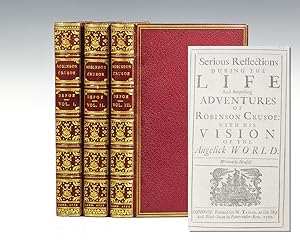
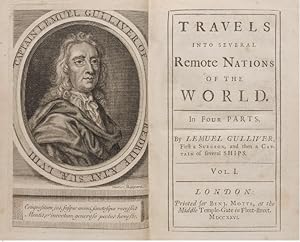
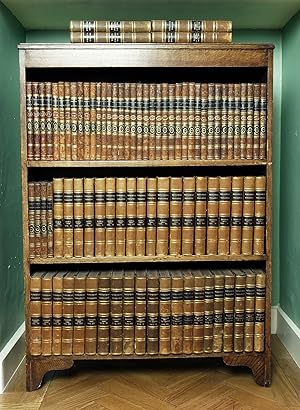
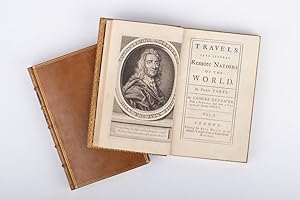
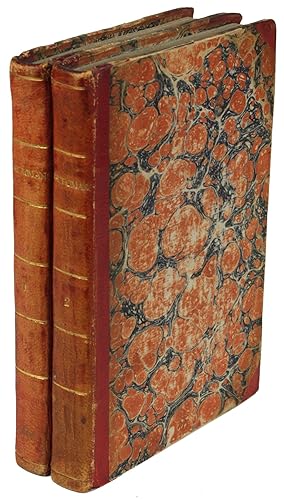
![Image du vendeur pour Candide, ou l'Optimisme, traduit de l'allemand de Mr. le Docteur Ralph [bound with] Candide, ou l'Otimisme, Seconde Partie [and] Remercîment de Candide à Mr. de Voltaire mis en vente par Biblioctopus](https://pictures.abebooks.com/inventory/md/md31431333092.jpg)
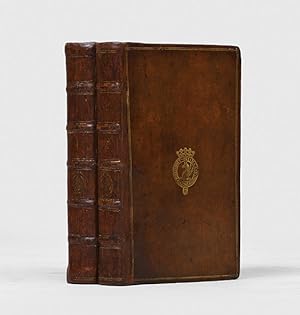
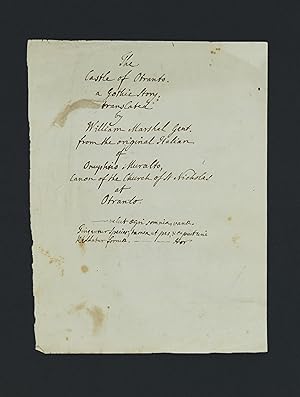

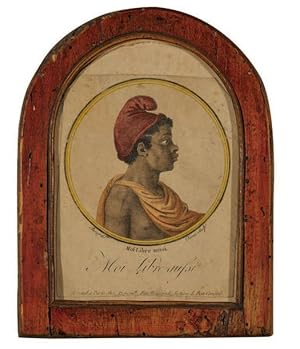
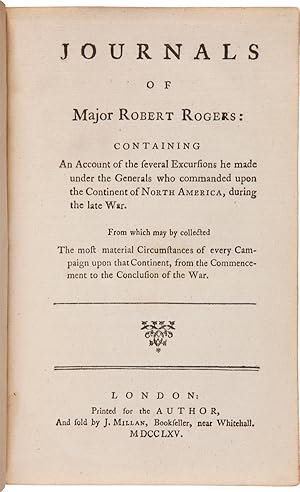
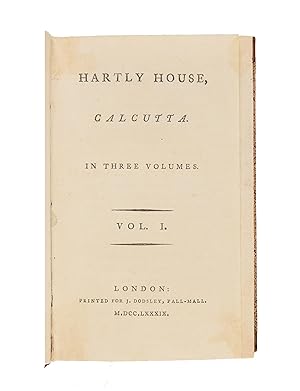
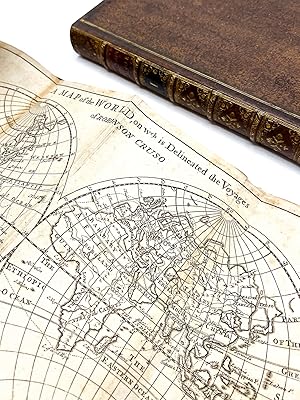
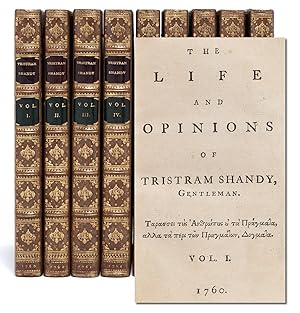
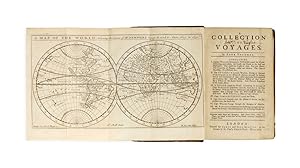
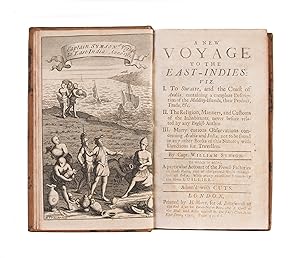
![Image du vendeur pour The Circular Tower [Reference Robison 30 (V/VI)] mis en vente par Trillium Antique Prints & Rare Books](https://pictures.abebooks.com/inventory/md/md30999261493.jpg)
![Image du vendeur pour The Trophy Staircase [Reference Robison 34 (V/VI)] mis en vente par Trillium Antique Prints & Rare Books](https://pictures.abebooks.com/inventory/md/md30999261494.jpg)
![Image du vendeur pour La Grande place, on strong laid paper [Reference Robison 31 (V/VI)] mis en vente par Trillium Antique Prints & Rare Books](https://pictures.abebooks.com/inventory/md/md30999265230.jpg)
![Image du vendeur pour The Fire [Reference Robison 32 (VI/VII)] mis en vente par Trillium Antique Prints & Rare Books](https://pictures.abebooks.com/inventory/md/md30999265231.jpg)


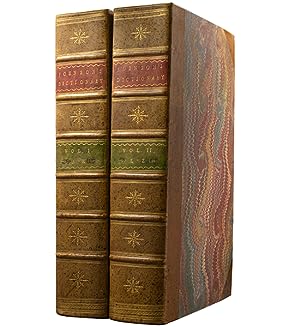
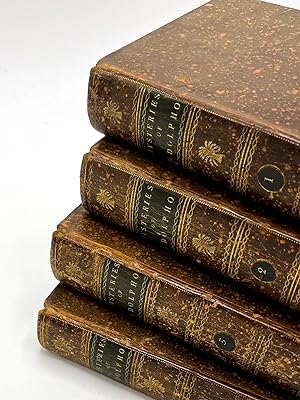
![Image du vendeur pour The Life and Opinions of Tristram Shandy, Gentleman [9 volumes] mis en vente par Arundel Books](https://pictures.abebooks.com/inventory/md/md31709361442.jpg)
